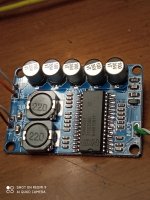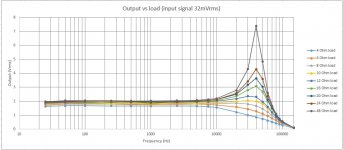if i read about this chip i marked this board:
TDA8932 Digital Mono Amplifier Board 15W 30W 35W Audio Stereo HIFI Module Speaker Volume Control Sound Board|Operational Amplifier Chips| - AliExpress
chris
TDA8932 Digital Mono Amplifier Board 15W 30W 35W Audio Stereo HIFI Module Speaker Volume Control Sound Board|Operational Amplifier Chips| - AliExpress
chris
Veering slightly off-topic but... I often see laptop "brick" style SMPS used for projects with these and TPA311x family of boards, and I realize it's not an ideally clean source of power. Out of curiosity has anyone tried using a din rail power supply (mean well has a ton of a options) as a power supply for this or similar class D board projects?
Hello TB,
From the TPA3116D2 data sheet; "Feedback Power-Stage Architecture With high Power Supply Ripple Rejection reduces PSU requirements".
I tried a simple 12V 2.5 Amp plug into the wall power supply, it made no difference whatsoever to the sound.
I do use a 12V (for 4 Ohm speakers) 8.5 Amp LED SMPS for my 3116. TI are one step ahead of the game 🙂
Cheers
From the TPA3116D2 data sheet; "Feedback Power-Stage Architecture With high Power Supply Ripple Rejection reduces PSU requirements".
I tried a simple 12V 2.5 Amp plug into the wall power supply, it made no difference whatsoever to the sound.
I do use a 12V (for 4 Ohm speakers) 8.5 Amp LED SMPS for my 3116. TI are one step ahead of the game 🙂
Cheers
Having read the first few pages here, I got itched and ordered a bunch of these three bucks boards form Chinesistan. I'm curious what I'm awaiting 😉.
Best regards!
Best regards!
My chinesium 3116 made huge difference if I changed crappy PSU with good one. That difference was even bigger with TDA8932 which sounded horrible and less horrible. Transformer+few capacitors was just so much better I kept it until I bouht a proper power supply specially meant to be used in audio applications. Those Ali supplies are actually really well designed for the money.
I'm planning to build a clonewheel Hammond organ and give it to my youngest brother, who is a church organist, as a present for his 60th birthday in 2022. As the Hammond emulator also provides a rather convincing stereophonic Leslie emulator, I'll build in three or four of these TDA8932 as power amplifiers. Still I don't know if I'll need three or four modules, as there are two possible options: A real Leslie 122 or 147 crosses it's speakers over at 800 Hz, so I'll do that also, but with active xovers. And I'll have to try out whether it is convincing enough to feed the bass driver with the sum of both channes or if it is better to build two separate channels with dedicated xovers for each one.
I think that these boards will do as musical instruments sufficiently.
Best regards!
I think that these boards will do as musical instruments sufficiently.
Best regards!
Hello all,
I found that introducing capacitors, other than those onboard SMPS power supplies, made the sound warm and pleasant. But, the lower end of the register suffered as did the upper end with a slight slurring of 'sharply' played instruments.
Removing the caps re-introduced the almost original* Class A bright, fast and detailed sound that Class D amplifiers were made to emulate and very successful they are too.
It's the audio dichotomy. One clue is to be found in the Class D Data Sheets words similar to these: "Feedback Power-Stage Architecture With High Power Supply Ripple Rejection Reduces PSU Requirements" meaning that one can use a laptop brick.
Cheers
* The Wiliamson valve Class A and the John Linsley Hood transistor Class A. Modern Class A is soft.
I found that introducing capacitors, other than those onboard SMPS power supplies, made the sound warm and pleasant. But, the lower end of the register suffered as did the upper end with a slight slurring of 'sharply' played instruments.
Removing the caps re-introduced the almost original* Class A bright, fast and detailed sound that Class D amplifiers were made to emulate and very successful they are too.
It's the audio dichotomy. One clue is to be found in the Class D Data Sheets words similar to these: "Feedback Power-Stage Architecture With High Power Supply Ripple Rejection Reduces PSU Requirements" meaning that one can use a laptop brick.
Cheers
* The Wiliamson valve Class A and the John Linsley Hood transistor Class A. Modern Class A is soft.
So in the meantime five pc. of this boards have arrived, as usual with Chinese items without any documentation 🙄. As each board represents a BTL amplifier, output terminals become clear: They're balanced w.r.t GND. But what's up with the input? Do I need a balanced signal or is an unbalanced one sufficient?
Best regards!
Best regards!
So in the meantime five pc. of this boards have arrived, as usual with Chinese items without any documentation 🙄. As each board represents a BTL amplifier, output terminals become clear: They're balanced w.r.t GND. But what's up with the input? Do I need a balanced signal or is an unbalanced one sufficient?
Best regards!
I just use an unbalanced signal input and found that connecting the power input grounds between the two boards slightly lessens the noise. I still get a bit of noise without a signal but everything seems tickety-boo when a signal is passed through.
Thanks to both of you, very appreciated! The noise supposedly is because there's no ground loop breaking resistor on these boards? I'll have to consider this when installing four boards into the Hammond clone organ project, as I plan to feed all those power amp boards and the sound engine from the same SMPS.
Otherwise I'd have to provide five dedicated SMPS's.
Best regards!
Otherwise I'd have to provide five dedicated SMPS's.
Best regards!
I got a couple of those "35W" TDA8932 mono boards, used 2 pcs for stereo. Found that they produce high pitch noise.
I tried a few things:
Seperate power for each module: No change
Add resistor at input: Reduce only overall noise, but high pitch noise remained as loud.
Any idea what may be the problem?
I tried a few things:
Seperate power for each module: No change
Add resistor at input: Reduce only overall noise, but high pitch noise remained as loud.
Any idea what may be the problem?
I took some measurements today
idle power consumption: 50mA @24V (1.2W)
No signal output (@8 Ohm load): 5mVpp approx 360kHz sinusoidal plus 20mV switching spikes containing damped 50MHz energy
Small signal frequency response (@8 Ohm load)
-3dB : 6Hz to 18kHz
-6dB : 3Hz to 42kHz
George
idle power consumption: 50mA @24V (1.2W)
No signal output (@8 Ohm load): 5mVpp approx 360kHz sinusoidal plus 20mV switching spikes containing damped 50MHz energy
Small signal frequency response (@8 Ohm load)
-3dB : 6Hz to 18kHz
-6dB : 3Hz to 42kHz
George
Attachments
Does anyone know the schematics of the boards presented in posting #1? Does it conform with the one in Fig. 37, page 38, of the NXP TDA8932B datasheet?
Best regards!
Best regards!
Hey fellas, futzing with a couple pairs of these at the moment and love the sound. Prefer them to my 3118s so far.
Does anyone have a recommendation for a 20uH air-core inductor that plays nice with the board? I realize that size will be issue and I'll have to re-evaluate my cap layout.
Does anyone have a recommendation for a 20uH air-core inductor that plays nice with the board? I realize that size will be issue and I'll have to re-evaluate my cap layout.
Attachments
- Home
- Amplifiers
- Class D
- Fasten seat belts. TDA8932 pessimistic review.





